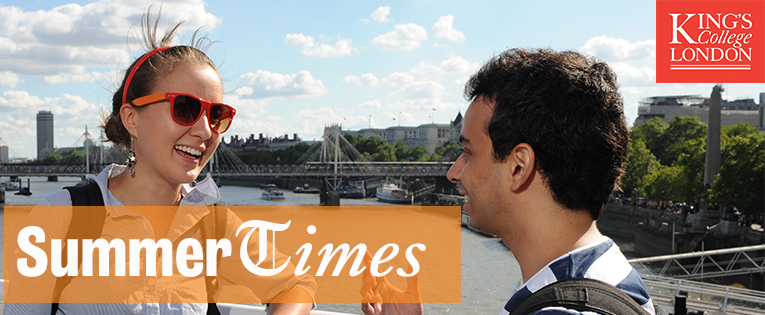
Vyki Sparkes, Curator of Social and Working History, with some of this year’s students at Museum of London Docklands
Sarah Castle, Higher Education Programme Manager at the Museum of London, and Beatrice Behlen, Senior Curator for Fashion & Decorative Arts, reflect on a memorable collaboration between the museum and King’s Summer Programmes.
‘Curating the City: 1900 to now’ is a course of two complementary halves; a morning of academic teaching at King’s on the Strand, followed by an afternoon going behind-the-scenes, exploring galleries and handling objects with curators at the Museum of London. Armed with the theory and critical insight provided by the lead tutor at King’s, students immediately get to see this theory put into practice as curators discuss both the art and science involved in curating the city of London.
This course introduces undergraduate students from a wide range of disciplines to a subject area largely unfamiliar to them. This year, courses being studied at home institutions ranged from Medicine to Industrial Design and from Information Engineering to Medicine. Students who wouldn’t usually learn together were united in their desire to find out more about the workings of a social history museum and to dig deeper into London’s history. ‘In-class’ and ‘at-museum’ discussions and activities meant that students got to hear the perspectives and opinions of classmates from countries and cultures often very different from their own. This year, we welcomed students from India, China, the US, Hong Kong, South Korea, Singapore and the UK.
We know from feedback that students love the hands-on aspects of the course and alternating lectures with activities at the museum; with comments such as ‘It is very different from anything I’ve ever done’ and ‘the curators were incredibly knowledgeable and helpful’ being common. But what do we at the museum like best about this collaboration? Above all, it is great to watch the students grow in confidence throughout the three weeks; confidence not only in asking questions, navigating the city, and understanding the collection and display decisions which museum professionals must make, but also confidence in thinking about objects. From the overriding desire in week 1 to simply identify what an object is, to a more reflective and interrogative approach to the material culture by week 3. As they develop skills of observing, touching and contextualising, so you see students’ faces light up as they begin to experience the very same passion for objects which is shared by all our curators.
Now in its 7th year, this Summer Programme continues to attract enthusiastic and industrious students who really appreciate and embrace the uniqueness of the teaching experience on offer. One of this year’s students commented: ‘If you love history and talking about historical artefacts, you’ll love this course’. We at the museum say: ‘If you love history and talking about historical artefacts, we’ll love having you on this course!’ Looking forward to welcoming next year’s cohort of London-curious students already…
